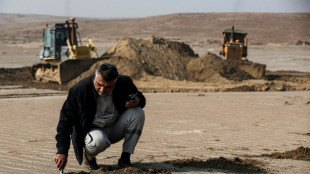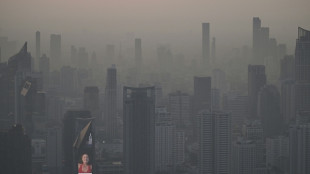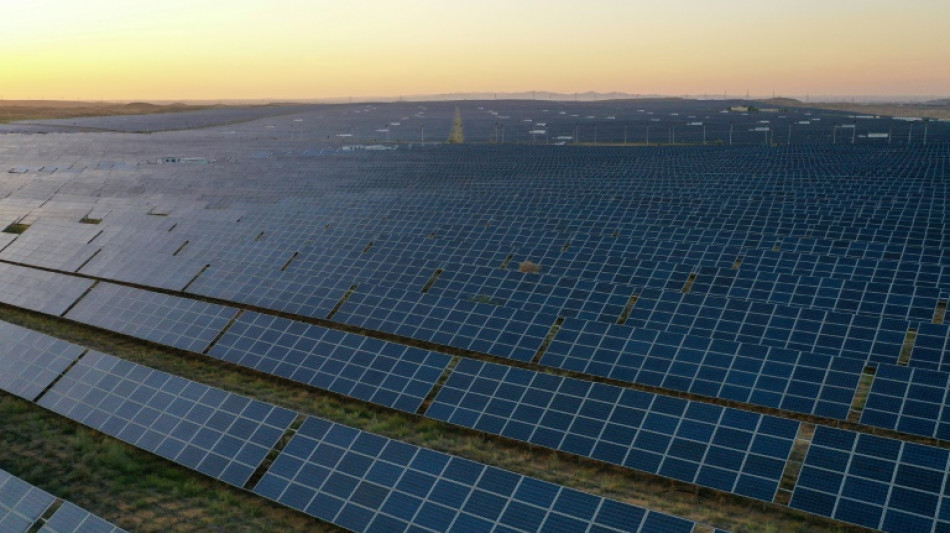
-
 Israel begins demolishing 25 buildings in West Bank camp
Israel begins demolishing 25 buildings in West Bank camp
-
Cambodian soldiers freed by Thailand receive hero's welcome

-
 Sudan lose to Burkina Faso as Algeria win again at Cup of Nations
Sudan lose to Burkina Faso as Algeria win again at Cup of Nations
-
Man City's Rodri and Doku could return against Sunderland

-
 French minister criticises Clooney's 'double standard' passport
French minister criticises Clooney's 'double standard' passport
-
Ukrainians wish for peace in 2026 -- and no more power cuts

-
 Glasner coy over Palace pursuit of Spurs striker Johnson
Glasner coy over Palace pursuit of Spurs striker Johnson
-
Neville labels Man Utd's draw with Wolves 'baddest of the bad'

-
 Stocks pull lower at end of record year for markets
Stocks pull lower at end of record year for markets
-
France plans social media ban for children under 15

-
 Mbappe suffers knee sprain in blow for Real Madrid
Mbappe suffers knee sprain in blow for Real Madrid
-
Putin wishes Russians victory in Ukraine in New Year speech
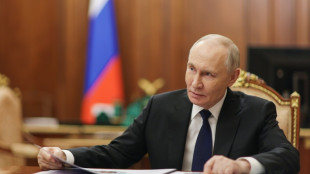
-
 Iran government building attacked as top prosecutor responds to protests
Iran government building attacked as top prosecutor responds to protests
-
World begins to welcome 2026 after a year of Trump, truces and turmoil

-
 Fofana reckons 'small details' restricting Chelsea's progress
Fofana reckons 'small details' restricting Chelsea's progress
-
Israel to ban 37 aid groups operating in Gaza
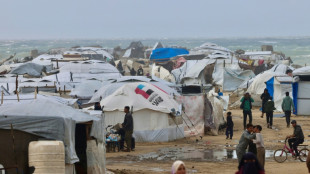
-
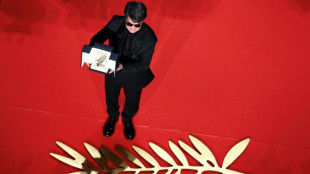 Filmmaker Panahi says Iran protests 'to move history forward'
Filmmaker Panahi says Iran protests 'to move history forward'
-
Xi says China to hit 2025 growth target of 'around 5 percent'
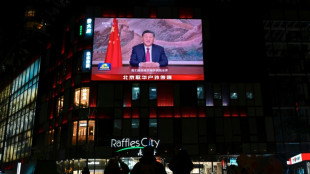
-
 Turkey steps up anti-IS raids, arresting 125 suspects
Turkey steps up anti-IS raids, arresting 125 suspects
-
Arteta says Arsenal reaping rewards for 'sacrifices and commitment'

-
 China says live-fire drills around Taiwan 'completed successfully'
China says live-fire drills around Taiwan 'completed successfully'
-
Nancy adamant he's still the man for Celtic job after Motherwell defeat

-
 Hoping for better year ahead, Gazans bid farewell to 'nightmare' of 2025
Hoping for better year ahead, Gazans bid farewell to 'nightmare' of 2025
-
Queen Camilla recalls fighting back against train attacker

-
 Stocks drop at end of record year for markets
Stocks drop at end of record year for markets
-
Amorim still 'really confident' about Man Utd potential despite Wolves draw

-
 Berlin says decision postponed on European fighter jet
Berlin says decision postponed on European fighter jet
-
Iran prosecutor pledges 'decisive' response if protests destabilise country

-
 Emery defends failure to shake hands with Arteta after Villa loss to Arsenal
Emery defends failure to shake hands with Arteta after Villa loss to Arsenal
-
China says to impose extra 55% tariffs on some beef imports

-
 Japanese women MPs want more seats, the porcelain kind
Japanese women MPs want more seats, the porcelain kind
-
Guinea junta chief Doumbouya elected president: election commission

-
 Pistons pound Lakers as James marks 41st birthday with loss
Pistons pound Lakers as James marks 41st birthday with loss
-
Taiwan coastguard says Chinese ships 'withdrawing' after drills

-
 France's homeless wrap up to survive at freezing year's end
France's homeless wrap up to survive at freezing year's end
-
Leftist Mamdani to take over as New York mayor under Trump shadow

-
 French duo stripped of Sydney-Hobart race overall win
French duo stripped of Sydney-Hobart race overall win
-
Thailand releases 18 Cambodian soldiers held since July

-
 Tiny tech, big AI power: what are 2-nanometre chips?
Tiny tech, big AI power: what are 2-nanometre chips?
-
Libyans savour shared heritage at reopened national museum

-
 Asia markets mixed in final day of 2025 trading
Asia markets mixed in final day of 2025 trading
-
Global 'fragmentation' fuelling world's crises: UN refugee chief

-
 Difficult dance: Cambodian tradition under threat
Difficult dance: Cambodian tradition under threat
-
Regional temperature records broken across the world in 2025

-
 'Sincaraz' set to dominate as 2026 tennis season kicks off
'Sincaraz' set to dominate as 2026 tennis season kicks off
-
Bulgaria readies to adopt the euro, nearly 20 years after joining EU

-
 Trump v 'Obamacare': US health costs set to soar for millions in 2026
Trump v 'Obamacare': US health costs set to soar for millions in 2026
-
Isiah Whitlock Jr., 'The Wire' actor, dies at 71

-
 SoftBank lifts OpenAI stake to 11% with $41bln investment
SoftBank lifts OpenAI stake to 11% with $41bln investment
-
Bangladesh mourns ex-PM Khaleda Zia with state funeral
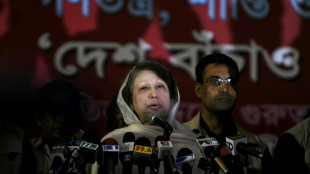
| SCS | 0.12% | 16.14 | $ | |
| RYCEF | 0.83% | 15.58 | $ | |
| RBGPF | 0.42% | 81.05 | $ | |
| CMSC | 0.36% | 22.765 | $ | |
| JRI | 0.22% | 13.61 | $ | |
| BCC | 0.34% | 74.04 | $ | |
| NGG | -0.4% | 77.46 | $ | |
| RIO | -0.6% | 80.04 | $ | |
| GSK | -0.42% | 49.095 | $ | |
| BTI | 0.24% | 56.685 | $ | |
| VOD | -0.08% | 13.22 | $ | |
| BCE | 1.03% | 23.815 | $ | |
| CMSD | -0.22% | 23.08 | $ | |
| RELX | -1.12% | 40.655 | $ | |
| AZN | -0.46% | 92.09 | $ | |
| BP | -0.13% | 34.705 | $ |

China's solar sector blazes trail in commitment to renewables
Hundreds of rows of gleaming panels blanket swathes of scrubby sand at sunset in a remote northern Chinese desert -- once the biggest solar farm in the world.
On the edge of the forbidding Tengger desert, the solar park produces 1.5 gigawatts of power -- but it has since been eclipsed and the largest is now further west with more than double the capacity.
China, the world's biggest emitter of greenhouse gases, is building almost twice as much wind and solar capacity as every other country combined.
Last week, its wind and solar capacity overshot a target set by President Xi Jinping nearly six years ahead of schedule.
The vast solar arrays in the Ningxia region are a testament to a state-led industrial policy that has driven that breakneck growth.
South of the regional capital Yinchuan, huge lorries roar down a highway flanked by photovoltaic panels and wind turbines stretching to the horizon.
Ningxia, like much of China's northwest, is sparsely populated and sun-soaked, pockmarked with small farms, vineyards and hulking power stations.
This geography makes it a prime location for generating solar power, which is then sent to China's eastern and southern provinces where electricity demand is highest.
"China's solar energy is developing at an unprecedented pace and scale," said analyst Wu Di from Peking University's Institute of Energy.
The country increased its installed solar capacity by more than 55 percent last year, according to the National Energy Administration.
China now accounts for over 40 percent of the total installed capacity worldwide, said Wu.
- 'Need for coal waning' -
Beijing aims to bring emissions of planet-heating carbon dioxide to a peak by 2030 and to net zero by 2060, part of its commitments under the Paris climate accord that seeks to limit global warming to 1.5 degrees Celsius above pre-industrial levels.
"Carbon can't peak unless incremental consumption demand is covered entirely by incremental growth in clean energy," said David Fishman, a senior manager at the Lantau Group specialising in China's power sector.
"Incremental solar capacity growth is an important part of making sure all power demand growth is met by clean sources."
The government only permitted around nine gigawatts of new coal power in the first half of 2024, a year-on-year reduction of 83 percent, according to a report published this month by the Centre for Research on Energy and Clean Air.
"With new renewable energy installations now capable of meeting all incremental power demand in China, the need for new coal is waning," the Finland-based independent research group said.
But it also warned that construction continued on existing coal projects, potentially slowing Beijing's energy transition.
- Industry shake-out -
The blistering pace at which extra solar capacity has been added has not quite been matched by developments in the power grid, causing some energy to be lost -- a phenomenon known as curtailment.
In May, Fitch Ratings said this could continue to rise in the near term, with the solar curtailment rate for the first quarter of 2024 increasing to four percent.
"In the future, in order to control the solar curtailment ratio within a reasonable range, China still has lots of work to do," said Wu.
Transferring power from west to east is also "not the most cost-effective approach", said Gao Yuhe from environmental group Greenpeace East Asia.
Besides the behemothic parks in the north, China's solar revolution has also relied on distributed solar energy -- smaller panels set onto rooftops in residential and commercial areas, which reduce transmission losses.
But even this smaller-scale infrastructure needs upgrading to cope with recent increased capacity, said Wu.
Long backed by generous government subsidies, China's domestic solar-panel industry is struggling with a global oversupply crisis that has driven down prices and pushed some firms into bankruptcy.
Fishman, of the Lantau Group, said the intense competition "is good news for builders, who continue to benefit from the cheapest panels the world has ever seen".
"Once a few of them go toes-up because they can't endure the competition, the market should stabilise," he added.
Chinese subsidies have also created friction with global trading partners, with the EU launching an investigation to discern whether the subsidies have helped homegrown firms undercut European rivals.
Beijing denies that its industrial policies are unfair and has initiated a series of probes into European imports in apparent retaliation.
Ch.Havering--AMWN

